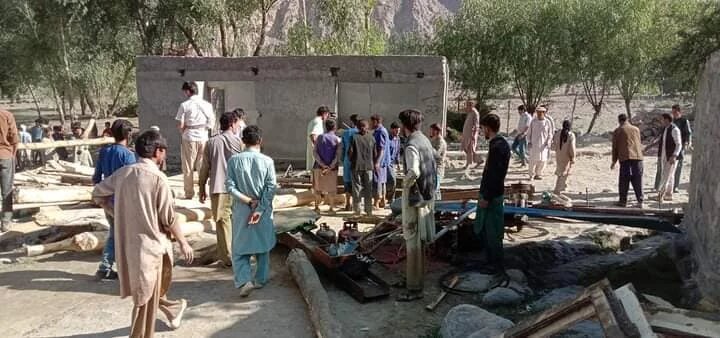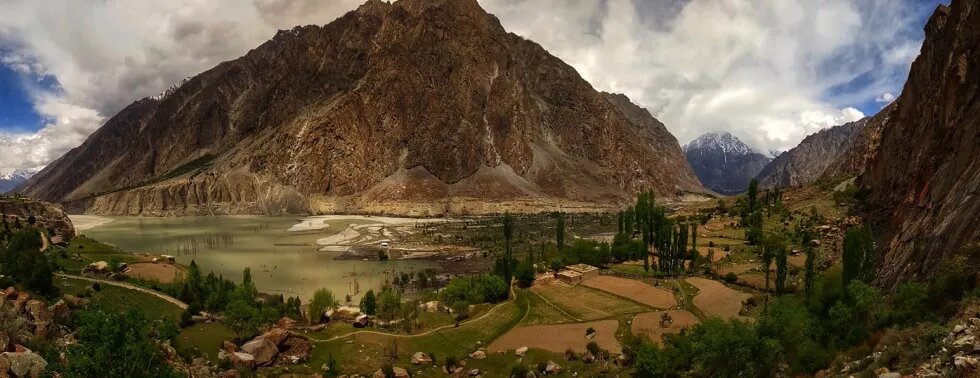
Global warming triggered damage to thousands of glaciers in the country’s northern provinces threatens ecology as well as lives.

Pakistan is an agricultural country and its agriculture is more dependent on rivers than monsoon rains. The mighty Indus river, in particular, starts from Tibet and then flows through the province of Gilgit-Baltistan (GB), irrigates the provinces of Khyber Pakhtunkhwa (KP), Punjab and then Sindh before falling into the Arabian Sea.
The Indus is entirely dependent on the glaciers in the northern part of the country. There are more than 6,000 glaciers in northern Pakistan, including GB and KP. These are clean water reservoirs that actually irrigate Pakistan. But these glaciers are changing rapidly due to climate change. The ecosystem of these areas is changing. Global warming has accelerated their melting.
According to a study of Pakistan Meteorological Department[i] in 2013, there are 3,044 lakes around these glaciers, which have now risen, causing severe damage to local community. They are enabling flood situations in many parts of GB and KP. In this article we will talk about Badswat Valley in the district of Ghizer of GB. It is an area where glaciers are wreaking havoc and the local people need help.
Badswat incidents
It was 17 July 2018 when the huge glaciers in the lush green area of Badswat Valley released water from their glacial lakes, destroying the pastures of the area and a 0.68 km long lake appeared in the area. As flood water entered into houses, 40 houses in one of the few residential rows of the area were partially damaged. Neither the media nor the administration could reach for help as the area is far from the city.
The area is quite underdeveloped without a proper communication system. There is no proper infrastructure either that would connect it with the cities. The entire area is dependent on livestock and farming. Pastures are limited on which the cattle graze and people grow crops for themselves. Most of the fruit farms and grazing lands have been lost due to formation of lake in the floods.
Exactly three years later, on 18 July 2021, the giant glaciers caused another flood situation because due to melting of glaciers another small lake was created. Let's take a look at why this ice lake erupted here again.
Badswat glaciology
Badswat is an area of Koramber Valley located in Ghizer district of GB. The area is located 120 km west of Gilgit with the Hindu Kush mountains to the east. The source of water in Badswat is a small river, which rises from Karamber Pass at an elevation of 4,320 metres. It passes through Ishkoman, and then falls into the Gilgit river, a tributary of the Indus. There are small settlements along the river in this area.
The total catchment area of the valley is 2,861.8 square kilometres. The highest peak of the valley Kampir Dior with an elevation of 7,168 metres is connected with Batura and Yishkuk mountains. In addition to Karambar, there are 286 small and large glaciers to the north of the valley, and a few glaciers to the Ishkoman side, but the glaciers situated in the north are surging towards the riverside and blocking the flow of water. So the fear of damage to the valley’s downstream increases; both glaciers can form glacial lakes through snowfall in winter and melting in summer. These glaciers can also create glacier dams in the area by blocking the river. A total of 459.6 sq km area of valley contains glaciers, which make up 16 per cent of the total area.
The question also arises as to whether the number of avalanches has been increasing in the last few years or whether it also happened in the past. In this regard, from the available records of Pakistan Meteorological Department[ii], it was found that from 1844 to 2004, there were about 18 floods in these areas in which small lakes were formed and sometimes small ice lakes erupted.
In the meantime, the lake in the area, which used to be small, has now become larger. The people of the area are worried that if anything happens again in the coming years, their area will be completely destroyed. In such a situation, what is the government doing? What steps have been taken so far to help the affected people?Ali Madad, a resident of Badswat owning a small shop and working as a fruit grower, says that the events of 2018 and 2021 were among the most severe ones. Particularly, he says, the tragedy that took place on 18 July 2021 destroyed 628 kanals of agricultural land (one kanal is equivalent to 0.125 acre) in the area, damaged 36 shops and 15 houses with more than a thousand fruit trees.
Government steps
Out of the more than 6,000 glaciers and 3,000 glacial lakes in the northern part of Pakistan, six lakes were declared dangerous, according to a 2013 report by the meteorological department. Now the number of the lakes has increased. The lakes are affecting the lives of 7.1 million people in GB and KP, and they need to be protected. It becomes very important as 22 per cent of the population in these areas live below the poverty line. Due to financial and technical constraints, providing modern technical facilities to these areas to mitigate the damage caused by melting glaciers is an uphill task for the government.
In 2011, the United Nations initiated a project, Glacial Lake Outburst Flood (GLOF), with the Government of Pakistan under the Green Climate Fund. As part of the project, early warning systems were installed in Bagrot Valley and Dronga Valley to alert people in advance about the situation of flood to reduce the damages.
There are more than 18 glaciers in the Bagrot Valley, which was severely affected in summer but due to the implementation of the project, the damages in the valley could be checked to a large extent. After its completion in 2016, the project has been expanded to increase the number of the early warning systems in GLOF-II. Weather stations will be set up to collect data on the rivers to prevent the people of GB and KP from being devastated by the glaciers, but this is not enough. So far, the programme has only been able to reach specific areas. In addition, some private companies are providing technical support in various areas, but increasing global warming has sounded the alarm bells. Incidents of flood in the Shimshal Valley and Ishkoman Valley this year could not be prevented; no weather monitoring stations have been set up in those areas yet.
The International Centre for Integrated Mountain Development (ICIMOD)[iii], which works on climate change in the Himalayan and Hindu Kush glaciers, released a report at the 25th World Environment Conference (COP 25) in Madrid in 2019. In the report, it was revealed that the glacial areas of Pakistan, Nepal, India and Afghanistan will experience higher temperatures than the rest of the world, which could have a very negative impact on these regions. A research report published by the Global Change Impact Study Centre in Pakistan has revealed that Pakistan's temperature has already risen by 1.5 degrees above the rest of the world. It is alarming because it was expected to happen ten years from now[iv].
In GB and KP provinces, there has been a huge increase in traffic in recent years due to increasing developmental work in the tourism sector. An estimated 1.5 million to 2 million tourists visit these areas annually. Therefore, the hotel industry is growing rapidly.
On the other hand, deforestation is also on the rise in both the provinces. Due to lack of energy, people mostly use wood as fuel.At the moment, deforestation is on its peak because the hotel industry is also flourishing and locals are cutting trees for construction of hotels.
There is no authority to control the rising tourist influx, though a plan was drawn up a few years ago to check the influx of vehicles. It was decided that monitoring stations will be set up near Babusar top, Chilas and Hundrab (near Shandur top) to control carbon emissions by preventing high-emission traffic from entering these areas as black smoke coming from vehicles plays a major role in melting the giant glaciers. But so far, implementation of the plan at the ground has not been seen at the ground level.
On the other hand, the Gilgit-Baltistan Environmental Protection Agency (EPA) has not yet set up a plant to make the area plastic-free, though plastic pollution is also a major threat for the glaciers. It not only creates blockages on streams but also, upon burning, releases hazardous chemicals triggering acceleration of the melting process. Efforts should be made to ban the use of plastic like the Pakistan Federal EPA did in the capital Islamabad. Moreover, transition needs to be made from traditional tourism to eco-tourism.
Rising global temperatures are accelerating the melting of glaciers and, consequently, increasing river flows. Yet, the governments of GB and KP are not in a position to take steps to protect the people from melting in the glaciers of both the provinces as it requires huge investments, technically skilled personnel, modern equipment and resources. The Government of Pakistan does not have the resources to deal with them. The GLOF programme was launched by the United Nations, but there are still many areas where early warning systems could not be installed.
Besides, the early warning systems installed under this programme only issues alerts, the exact timing of when a lake eruption will occur is not determined and the local population becomes frightened. The timing of the eruption of the glacial lakes has to be determined accurately so that the people take steps to prevent it.
Of course, the government initiatives have started a series of relief operations in these areas which, if extended, will protect people from the situation created by the eruption of glacial lakes. Protecting the people as well as the glaciers is a top priority.


